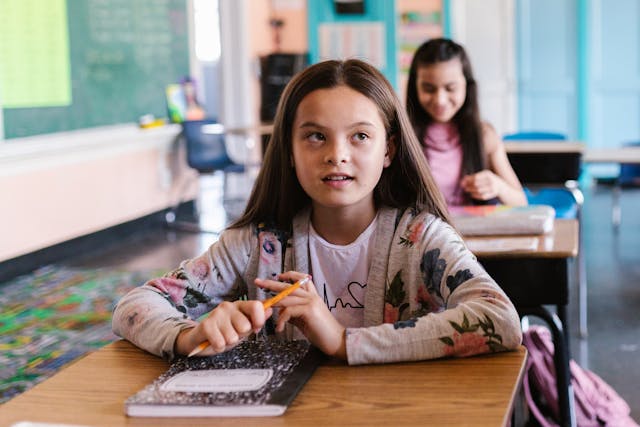
25 Classroom Management Hacks
Here are 25 classroom management strategies that can help you in your classroom. They can be easily modified and adjusted.
1. The "Invisible Proximity" Trick
Instead of calling out disruptive behavior, simply walk near the student. Without stopping your lesson or making eye contact, your presence alone often reminds them to refocus without public confrontation.
2. The "Delayed Response" Approach
If a student misbehaves, pause briefly before addressing it. This gives them a chance to self-correct and prevents unnecessary confrontation or escalation.
3. The "2x10" Relationship Builder
Spend two minutes per day for ten days engaging in casual, non-academic conversations with a challenging student. This builds rapport and often reduces behavioral issues.
4. The "Secret Signal" System
Establish silent cues with students (e.g., a head nod for "stay on task," a tap on the desk for "lower your voice") to correct behavior discreetly without disrupting the lesson.
5. The "Mistake-Friendly Environment" Rule
Normalize mistakes by deliberately making small errors so students can correct you. This reduces fear of failure and encourages participation.
6. The "Decoy Praise" Strategy
Instead of calling out bad behavior, praise a nearby student who is on-task. Example: "I love how Alex is focused and ready to learn!" This often prompts others to follow suit.
7. The "Start Soft" Redirect
Instead of using a loud voice to redirect behavior, start with a whisper or a calm tone. Students naturally quiet down to hear you, reducing tension.
8. The "Reverse Teacher" Strategy
Let a student briefly take charge of a lesson or discussion. This increases engagement, responsibility, and encourages peer respect.
9. The "Three Before Me" Rule
Before students ask the teacher a question, they must check with three classmates first. This fosters independence and peer collaboration.
10. The "Preemptive Exit Ticket"
Before a transition, students quickly write:
- One distraction they'll avoid next lesson.
- One goal they'll focus on.
This improves intentionality and smoother transitions.
11. The "One-Liner Redirect"
Use neutral, non-confrontational one-liners like:
"We're not doing that right now."
"Let's focus on the lesson."
These avoid power struggles and keep the class moving.
12. The "Beat the Timer" Challenge
Set a short timer and challenge students to be ready before it runs out (e.g., "Let's see if everyone can have their books open in 20 seconds-go!"). This makes transitions fun and efficient.
13. The "Classroom Jobs with Status" Trick
Assign meaningful classroom jobs (e.g., "Tech Guru," "Question Captain," "Noise Monitor"). Giving students responsibility boosts engagement and ownership.
14. The "Selective Ignoring" Strategy
Strategically ignore minor attention-seeking behaviors to avoid reinforcing them. Works best for low-level disruptions, not serious issues.
15. The "Mystery Motivator" Game
Write a secret reward on a note card and seal it. If the class meets behavior expectations, reveal the reward. The mystery factor keeps students engaged.
16. The "Whisper Countdown" Technique
Instead of loudly counting down, whisper it (e.g., "3...2...1..."). Students naturally quiet down to hear you.
17. The "Sticky Note Boost"
Leave personalized sticky notes on desks with encouragement ("I see how hard you’re working-keep it up!"). This improves motivation and behavior.
18. The "Do Now" Warm-Up
Start every class with a quick task on the board (e.g., a journal prompt, math problem). This eliminates wasted time and gets students engaged immediately.
19. The "Hallway Reset"
If a student enters class in a bad mood, ask them to step outside for 30 seconds to reset before rejoining. This prevents unnecessary disruption.
20. The "Random Participation Picker"
Use popsicle sticks, dice, or an app to randomly select students for participation. This keeps everyone engaged and prevents only a few from dominating discussions.
21. The "Write It Down" Method
Instead of verbally addressing minor disruptions, write the student's name on a notepad and make eye contact. The student knows they've been noticed without public confrontation.
22. The "Positive Phone Call Surprise"
Make a random positive phone call home for students demonstrating good behavior. This builds student confidence and strengthens parent relationships.
23. The "Music for Focus" Hack
Play instrumental music (e.g., classical, lo-fi beats) during independent work. The right music can increase focus and reduce distractions.
24. The "Compliment Chain"
Start class by having one student compliment another, then continue the chain. This fosters a positive, supportive classroom culture.
25. The "End on a High Note" Strategy
Always wrap up lessons with something fun, uplifting, or reflective (e.g., a quick joke, a positive statement, a short success reflection). This leaves students with a good final impression of the class.
Not all of these will work for you. Try some and see how it goes!
Top Teacher Career Articles
* Privacy Policy